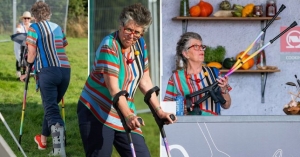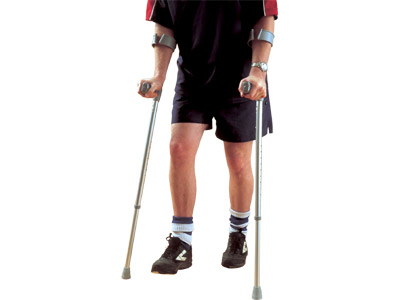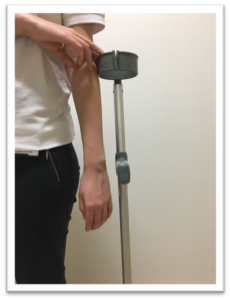The low down on using crutches
People get given crutches for a number of different reasons. Depending on what you need them for can determine how to use them correctly.
It is also important to realise that crutches are hard work and will cause more damage than good if used unnecessarily or incorrectly. However, if you have been advised to use them by a healthcare professional, it is better to walk well by using crutches than it is to walk badly without them. If you have been given crutches by a healthcare professional they should have guided you whether they are being provided for full support to ensure you do not put weight through your leg OR that they are there just to support your normal walking. This is important to determine how much weight you should be putting through your leg and how much you should be putting through the crutches. If you are not sure then get in touch to arrange an appointment with one of our Physiotherapists, as this information is important.
In the UK the majority of people are supplied with elbow crutches.
These have a handle to put pressure through your hands and a cuff that goes around your forearm. These are most commonly measured to fit by adjusting the length so that the handle is the height of the crease of your wrist when standing with your arms relaxed down by your side. It is important to have your crutch at the correct height for you. If the crutch is too high it can cause excess stress your shoulder and neck, or worse can put you off balance. If the crutch height is too low it causes you to stoop forward and have poor posture, this can increase the stress on your wrist and hand and will negatively impact your walking pattern.
If your crutches have been provided to allow you to walk without putting any pressure on your injured leg then you will either be non-weight bearing (NWB) or will be touch weight-bearing (TWB). With NWB you do not let the injured leg touch the floor at all and all of the support comes from your arms through the crutches. If you are TWB then you can allow the toe of your injured leg to touch the floor but are not to put any weight through that leg. The weight still goes through your arms. Both of these techniques are used following some fractures or surgeries. It can be hard work to get around like this but it is necessary to protect your injury for a short period. It is not recommended to use this technique if it has not been prescribed as it greatly impacts your walking pattern.
The other use for crutches is to support your normal walking pattern whilst taking some of the pressure off. This is commonly prescribed as weight-bearing as tolerated (WBAT). This means you use the crutches alongside your injured leg, whilst maintaining a normal walking pattern, and put as much weight through the leg as pain allows. This allows you to maintain a good heel-toe walking action and a nice even stride length, which will minimise the risks of secondary problems that come from spending time on crutches. If allowed this is a much healthier way to use them. Try to keep your hands soft and your shoulders relaxed as much as possible.
To get the correct gait with crutches you should always aim to keep your crutches alongside the injured leg. The easiest and most supportive way to use them is with a ‘step to’ gait. This technique means you place both crutches and your injured leg out in front of you then take a small step with your uninjured leg so that it is also level with your crutches. This small step allows you to put minimal weight through your leg without putting too much stress on your arms. The next progression is a ‘step through’ gait, this means you step your good foot out in front past the crutches to mimic a more natural walking pattern. This will allow you to walk a little faster and more naturally but requires more balance and ankle mobility. Progress to this gait as able and increase your stride length as able as you improve.
As you improve and your injury heals there will come a time when you need to progress off of the crutches and back to walking without them. This is best done gradually. Once you are able to walk with a good, even stride length with a step through gait you can gradually decrease the amount of weight going through your hands. Once you feel ready you can progress to using just one crutch. Keep the single crutch in the hand furthest away from your injured leg and try to keep your body upright. Avoid leaning towards the crutch, by this time it should just be there for balance and minimal support. When you feel you are not needing to put weight through the crutch and it seems to be getting in the way you can try walking without it. Initially, it is best to do this in and around the house and for short distances in familiar environments and to keep a crutch for longer walks outdoors. At the very least crutches are a good visual aid for others in public to not bump into you. You may find at first that you are only able to do short periods without the crutches. This is perfectly fine to do some time with them and some time without. This will allow for a gradual progression back to longer periods of walking unaided and will minimise discomfort and the temptation to limp. It is better to walk better with a crutch than it is to walk badly without. Walking should be a subconscious skill when uninjured and can take some practice to relearn. Learning to walk well again requires lots of repetition of good habits and good technique.




